NICS@TNG contributes to solve the puzzle of the "super-rotation" of Venus's atmosphere
One of the mysteries of the Solar System is the fact that the atmosphere of Venus circles the planet sixty times faster than its rotation period, generating permanent winds with hurricane-like speeds. The quest for the mechanisms that sustain this "super-rotation" motivated one of the most complete and detailed studies about the nocturnal winds on Venus close to its surface.
This work, published on December 7th 2018 (and led by Javier Peralta involved in the Japanese mission Akatsuki), presents measurements of the wind speeds at the nightside lower clouds of Venus obtained combining observations from the first year of JAXA's Akatsuki mission together with new wind measurements from ground-based observations acquired with the Near Infrared Camera Spectrometer (NICS) installed at the Telescopio Nazionale Galileo and IRTF/SpeX. These results combined with previously published data suggests variations of up to 30 m s-1 in the winds at the nightside lower clouds of Venus.

Decadal variation of the zonal winds at the nightside lower clouds of Venus. Data correspond to time
averages of the zonal winds obtained between 30°S and 30°N with cloud tracking, except for panels (A)
and (D).
Blue dots represent time averages using wind speeds provided in previous publications. New data presented
in this work and based on cloud tracking measurements are shown by the red dots and were obtained from the
TNG/NICS (K), IRTF/SpeX (L and N), and Akatsuki/IR2 images (M). More information at the paper: http://iopscience.iop.org/article/10.3847/1538-4365/aae844/meta
(Fig. 13)
In order to create an ever more comprehensive picture of what is happening in the atmospheric circulation of Venus, one needs to know the winds, in detail and over time, in the several layers of its atmosphere. The Akatsuki mission, of the Japanese space agency JAXA, observed for one full year the night side of Venus, enabling the analysis of the clouds between 48 and 70 kilometres of altitude. One of the most important revelations, was the discovery of the acceleration of the winds, at those altitudes, in the dusk zone, in the transition between the day side and the night side of the planet.

Images adquired with the infrared IR2 camara installed in the Akatsuki's probe in 2016.
Créditos: ISAS/JAXA
"This is the first time it is detected, and will help understand the processes at the origin of the dramatic acceleration of the Venus atmosphere," says Pedro Machado co-author of the paper (Instituto de Astrofísica e Ciências do Espaço (IA) and Faculdade de Ciências da Universidade de Lisboa (FCUL). These winds at low altitude are totally different from those already being studied on the layers above. They can only be investigated through the analysis of the infrared light emitted by the planet itself.
"Due to the greenhouse effect produced by the atmosphere, the zone below 48 kilometres of altitude is so hot, so hot, that it emits a large quantity of thermal radiation, in the infrared," says Pedro Machado. "This radiation, once it hits the cloud layer, and being some of these clouds denser and others less, it traces their contour on the images obtained in the infrared. This way we can follow the cloud formations and build the wind map over time."
IA's Solar System research group collaborated directly with the Akatsuki mission because it developed a method that is complementary to the Japanese probe in the measuring of the winds in the infrared from telescopes based on Earth. As, throughout its orbit, the probe is not always over the night side, Pedro Machado used this method with the instrument NICS installed at the Telescopio Nazionale Galileo, in Canary Islands, in coordination with the Japanese mission, in order to guarantee a global observation, and as continuous as possible, of the planet Venus.
"This method is a great leap in terms of the precision in this domain, being now as competitive as the data from the infrared camera of the space probe," highlights Pedro Machado.
One of the team's next steps is to understand the relationship between the lower layers of the atmosphere and the features on the surface of Venus, such as mountains, and how this relationship might contribute to the mechanisms that trigger and sustain the "super-rotation" of the atmosphere of the planet.
More information at: http://iopscience.iop.org/article/10.3847/1538-4365/aae844/meta

